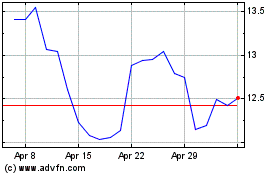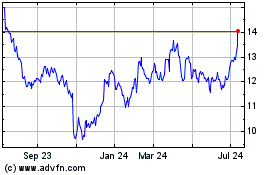Trump's Carrier Talks Up the Ante for Ford
December 02 2016 - 12:57PM
Dow Jones News
By John D. Stoll
President-elect Donald Trump's deal with United Technologies
Corp.'s Carrier this week to keep some jobs from moving to Mexico
raises the stakes for another company that faced substantial
criticism during the campaign: Ford Motor Co.
The Dearborn, Mich., auto maker offered an olive branch to Mr.
Trump last month by deciding to keep production of a low-volume
Lincoln product in Kentucky, rather than stick to its plan to
eventually build it in Mexico. That is just a minor victory for the
incoming administration because Ford is well on its way to spending
$1.6 billion to build a new factory in Mexico for production of
much higher-volume compact Focus cars.
Here's the background on where things stand:
What's behind Ford's Mexico strategy?
Ford's Mexico plan has been long in the making and is the only
way that executives expect they can stanch the losses associated
with small-car production. Compacts, sedans and coupes aren't
popular and command far lower prices than the trucks and SUVs that
deliver most of the profits for auto makers selling in the U.S.
Still, many industry participants see them as necessary to meet
fuel-economy standards because they help bring down the fleet
average. That is why cars like the Focus are referred to as
"compliance cars" in the industry.
Mr. Trump's administration is expected to take another look at
stringent fuel-economy standards in place through 2025, but auto
makers need to make investment decisions several years before they
actually produce a car. Mexican production not only cuts the labor
costs going into a Ford Focus, it also opens up more markets for
export seeing that Mexico has dozens of free-trade agreements. More
export destinations lessens the potential for unused factory
capacity, which is the most common reason that auto makers burn
cash.
Is moving to Mexico the only way to deal with unprofitable small
car production?
No.
General Motors Co. builds several models of small cars in the
U.S. and has made no indication it plans to change that strategy.
In 2009, as part of terms of its government bailout, the auto maker
agreed to keep a small car plant open in Michigan. That factory
operates well below its capacity, but it appears to be under no
threat of closing. The auto maker also utilizes other factories in
Michigan and Ohio for small-car output. GM hasn't disclosed the
financial performance of its individual vehicle lines.
(GM's CEO is among a group of business leaders set to meet
periodically with Mr. Trump beginning in February).
Fiat Chrysler Automobiles NV doesn't see small-car sales as a
key method for meeting fuel-economy requirements. As a result, it
is converting all of its U.S. car-assembly capacity into
light-truck capacity. This means that Dodge Darts and Chrysler 200s
are no longer made in the U.S. as of Friday. Next year, the company
will complete costly conversions of plants in Illinois and Michigan
for production of the small Jeep Cherokee SUV and the large Ram
pickup truck. Fiat Chrysler cut 1,300 jobs earlier this year due to
slack demand for the 200; the company estimates 1,000 will be added
when the converted factories begin humming again.
Do Detroit auto makers rely much on Mexico?
About 17% of the Detroit 3's North American output is currently
sourced from Mexico, according to WardsAuto.com, but all three auto
makers could see that percentage increase in coming years due to
planned investments. That compares to 21% for the broader auto
industry.
How many people will lose their jobs due to Ford's Mexico
move?
Ford has repeatedly said no one will lose their jobs as a result
of moving small cars to Mexico. Here's why: U.S. auto factory
workers are relatively expensive and executives want them building
their highest-margin vehicles. In the case of Ford, that means
taking the United Auto Workers members currently assembling Focuses
and redeploying them in 2018 to make a new model of a pickup truck
and a new SUV. Because so few people want a Ford Focus these days,
the transition could actually be a win for the UAW.
But it isn't all good news. It wasn't too long ago Ford was
saying UAW labor could profitably build small cars. The company has
thrown in the towel on that idea, and so there will be thousands of
new workers on Ford's payroll who aren't located in the U.S. -- and
that is a defeat for the UAW and ultimately a blow to U.S.
manufacturing.
And, Ford is putting all its American manufacturing eggs in the
light-truck basket, a move that could come back to bite the company
if gasoline prices were to spike and demand for pickups and SUVs
plummets as a result. More than 60% of vehicles sold in November
were light trucks; but it was only a few years ago when that
light-truck mix was well below 50%. Memories don't need to be too
long to remember when Ford and its domestic counterparts cut a lot
of jobs because truck demand was drying up.
How would a Trump tariff of 35% affect the price of a Ford
Focus?
A basically equipped Ford Focus can currently be had for about
$15,000, factoring in incentive, making it one of the more
affordable cars on the market. To get Ford's most basic SUV, the
Escape, the price tag goes up to about $23,000 even though the two
vehicles aren't radically different when it comes to underlying
parts.
Mr. Trump has proposed slapping a 35% tariff on a product like
the Focus if it were to move to Mexico, and that would jack the
price tag to above $20,000. Based on today's sales levels of
between 150,000 to 200,000 Focuses sold a year, such a tax would
add hundreds of millions in additional cost that the buyer or the
auto maker would need to shoulder.
Write to John D. Stoll at john.stoll@wsj.com
(END) Dow Jones Newswires
December 02, 2016 12:42 ET (17:42 GMT)
Copyright (c) 2016 Dow Jones & Company, Inc.
Ford Motor (NYSE:F)
Historical Stock Chart
From Mar 2024 to Apr 2024

Ford Motor (NYSE:F)
Historical Stock Chart
From Apr 2023 to Apr 2024
